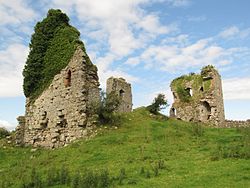| Gleaston Castle | |
|---|---|
| Cumbria, England | |
 Gleaston Castle's ruined north-west tower in 2015 | |
| Coordinates | 54°08′02″N 3°07′54″W / 54.1340°N 3.1317°W grid reference SD261714 |
| Type | Enclosure castle |
| Height | c.19 m (62 ft) (south-west tower) |
| Site information | |
| Owner | Private |
| Open to the public | No |
| Condition | Ruin – At Risk |
| Site history | |
| Built | 14th century |
| Built by | John Harington, 1st Baron Harington |
| Materials | Limestone (main material) and sandstone (details) |
Gleaston Castle is a medieval building in a valley about 1 kilometre (0.62 mi) north-east of the village of Gleaston. The village lies between the towns of Ulverston and Barrow-in-Furness in the Furness peninsula, Cumbria, England. Gleaston Castle has a quadrilateral plan, with a tower at each corner. The largest of these, the north-west tower, probably housed a hall.
The castle was most likely built for John Harington, 1st Baron Harington in the 14th century, replacing nearby Aldingham Motte. Gleaston Castle descended through the Harrington family until 1458 when it passed to William Bonville through marriage and was subsequently abandoned. The castle passed to the Grey family until Henry Grey, 1st Duke of Suffolk was executed for treason in 1554. As a result, Gleaston Castle became royal property before it was bought by the Preston family in the 17th century, and then passed to the Cavendish family.
As the castle was disused from the mid-15th century it fell into dilapidation, and antiquarian depictions from the 18th century show Gleaston in a state of ruin. Though it is not open to the public, it has been the subject of historical and archaeological investigation in the 20th and 21st centuries.
